By Pete Vack
All images courtesy Walter Bäumer and Dalton Watson unless otherwise noted.
The Maserati A6G 2000 Zagato by Walter Bäumer
ISBN 978-1-85443-249-0 Published by Dalton Watson Fine Books
290 mm x 295 mm 288 pages, 227 Black and White and Color photos
US $155 ON SALE NOW!!
Maserati history is just as significant, interesting and eventful as that of Ferrari. But as Michael Lynch noted, it would have been better if Maserati historians had begun their quest at the same time as Ferrari historians – back in the 1960s. By now a lot of history has gone by the wayside, few of the principles are left alive and remembering, and already many facts have been distorted for the prospect of a higher auction price or more prestige.
We applaud Bäumer’s decision to get as many facts down before they too, are muddled. I’d hate to have to wait for another 10 years before getting a chance too see the wonderful photos and findings now available in this book.
Anyone and everyone with even the slightest interest in Maserati, Italian cars, Italian coachbuilders, Italian competition events, and Zagato will buy this book and be thankful. I would suspect they will be tripping over themselves to get a copy, because one quick look through the pages will remind one that almost all of the Maserati Zagatos were as close to beautiful as Zagato ever came.
Zagato, at their worst, dished out some real clunkers in their time. Too long, too low, too chunky, some seemingly a caricature of their own products, others quick attempts to please a customer with cash in hand. This reviewer recalls staring at his Lancia Appia Zagato, in need of total restoration and wondering why bother. The Lancia Flavia was dramatic, edging on ugly, while the Bristol Zagatos were well off the mark and the Alfa 1900 Bullnose Zagato deserved the nickname. But, when they were good… and that was often… they were very good. And they were very good at donning the A6G 2000 Maseratis built for the road between 1955 and 1957. Perhaps it was the chassis dimensions combined with a healthy wheel size that allowed aggression to spring from every corner. Perhaps the car brought out the best in Zagato and their metal workers.
The first Maserati Zagato came about in the early 1930s, based on the singular V16, which according to Rob Box was,“…a monster to drive and very difficult to handle, although in a straight line it was merely a matter of courage.” Alfieri Maserati lapped Monza at 124.2 mph in 1929 with it, and Borzacchini won the Tripoli Grand Prix in 1930 with the car in racing trim. Later, it was given to Zagato to be converted to a road car. The spyder body was similar to the Alfa 2.3s of the time, but more aggressive, looking as powerful as it was in reality. It seems possible that Zagato bodied a few Type 26 Maseratis and I wouldn’t be surprised if a few of the 4CS 1100s of the early thirties were bodied by Zagato, but it’s difficult to confirm. The brothers Maserati were not interested in building cars for the street and that more or less nipped things in the bud right there.
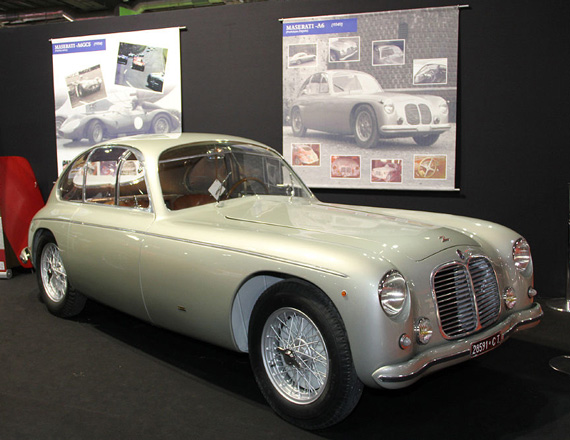
After the war, Elio Zagato experimented with the Panoramica design on the Maserati A6G 1500. Photo by Hugues Vanhoolandt.
Almost twenty years would pass before another Zagato-designed body was rolled, tacked and welded onto a Maserati chassis. The car was an A6G 1500, a six-cylinder SOHC car with a iron block which was a harbinger of things to come for the Orsi concern. Series production of road/GT cars commenced after the war with the A6G 1500 and the departure of the Maserati brothers, but it was sparse. Between 1946 and 1950 only sixty-one cars were produced and all were bodied by Pinin Farina. In 1949, chassis number 052 was bodied (or most likely re-bodied, as Robb lists chassis 052 being built in 1946) by Zagato, along the lines of the Panoramica theme that Elio Zagato was developing at the time. It was advanced and attractive, and recently was shown at the Paris Retro.
In the immediate postwar period, Omar Orsi was focusing on racing and the new line of A6GCS sports cars that doubled as F2 cars by the simple expedient of removing the fenders. Series production took a back seat, until by 1952 it became clear that the sale of sports and GT car would be necessary in order to support the racing efforts.
Nevertheless, only sixteen road cars were built from 1951 to 1953. The vast majority of these cars were equipped with the 2-liter SOHC engine introduced in 1951 and bodied by Frua, Pinin Farina and Vignale.
With the introduction of the chain-driven, twin-cam head (racing versions of the engine used gear-driven camshafts) in 1954, the 2-liter engine was transformed into a useful and competitive engine. As supplied with the twin plug head, the engines were reportedly good for 190 bhp. Zagato bodies were much lighter than the more luxurious Vignale or Fruas. This lucky combination of the two meant that suddenly the GT Maserati Zagato was the car of choice for young, rich gentleman who wished to compete in the Italian GT National classes.
Production of the A6/2000 soared (at least by Maserati standards), from four cars in 1954 to 12 in 1955, to the high point of 34 cars in 1956 and ending 1957 with a further 15 cars.
Twenty-one of the A6G 2000s were bodied by Zagato, the rest by Frua and Allemano. The Frua and Allemano versions were street GTs; the Zagatos, almost to a one, were lightweight, Spartan and particularly noisy cars designed for racing.
Bäumer is the author of a previous book on Maserati, “Maserati 300S,” in which he uncovers the history of each of the sport racers by serial number. He applies the same technique in his latest effort “Maserati Zagato,” also published by Dalton Watson. Up front, he provides some interesting information about GT racing in Italy, little heard of events that were covered only by the excellent magazine “Auto Italiana.” These very popular events, often in the form of hillclimbs, were the playground of the A6G 2000 Zagato, competing against the Otto Vu Fiats and Siatas and the Alfa 1900 Zagato. Bäumer discusses the role of Zagato and the technical development of the A6 series before getting into the history of each one of the Zagato-bodied cars.
The twenty one chassis have been broken down into four series:
Prototype and first series:
2101, 2102, 2105, 2106, 2107
Interim series:
2112, 2113, 2118/2188
Second Series
2121, 2122, 2123, 2138
Third series
2124, 2137, 2139, 2148, 2150, 2155, 2160, 2179, 2186
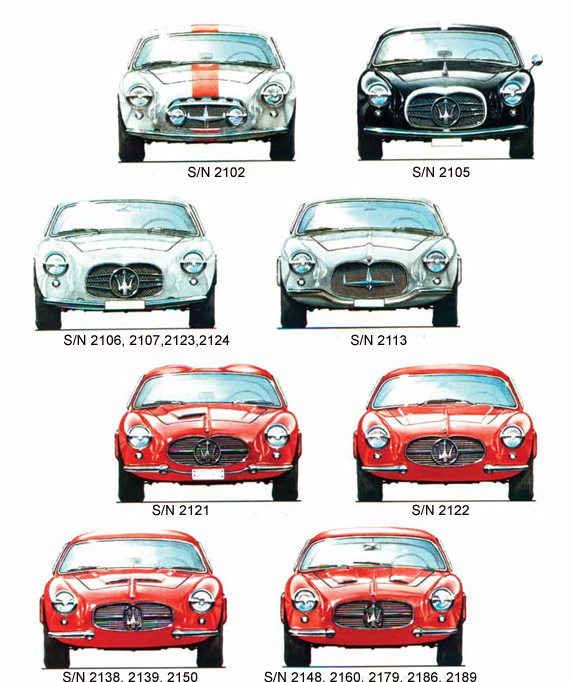
These drawings from the 1990s show the various designs for the radiator grill and hood. Note that not all cars are listed and the colors for S/N 2120 are incorrect.
Maserati’s GT cars were transformed from attractive, but overweight and underpowered boulevardiers, to fire-breathing competition berlinettas capable of beating all comers in the 2-liter classes. Significantly, seventeen out of the twenty-one Zagatos established a racing history. Fittingly, Adolfo Tedeschi won the 1956 under 2-liter Championship in Italy, and Giacomo Moioli won the championship again in 1959.
Even more remarkable is that only one of the cars has disappeared from sight and most have substantially complete histories. Ferrari and OSCAs are similar in this respect, and even during the period from 1965 to 1985, when the car were at the lowest point of their value, there was something about them that prevented their being shuttled to the nearest junk yard. For twenty years many of these cars were kept hidden in someone’s garage, or as in the case of S/N 2121, shipped back to Sicily from L.A. by mechanic Sal Di Natale and interred into a brick tomb to prevent theft. And there it remained until David Sydorick convinced Di Natale to sell it to him in the 1990s.Like Simon Moore’s “Immortal 2.9,” Bäumer weaves such interesting stories into the fabric of this history. For example, S/N 2101 was not only the first A6G 2000 Zagato, and the only spyder, but was planned to be purchased by Argentine dictator Juan Peron, whose sudden downfall meant that neither he nor Evita would take delivery. S/N 2102, a coupe, was used in practice for the 1956 Mille Miglia by Stirling Moss and Denis Jenkinson. A young Clint Eastwood poses by S/N 2112 for a photo shoot, reportedly in need of the money for the modeling assignment. S/N 2118 was renumbered by the factory after a serious accident, to S/N 2189. One that got away was S/N 2139, presumably dismantled by the factory after it too was severely damaged in a racing accident. Of course any competition car that has survived almost 60 years will have its share of tall tales to tell.
It seemed that from 1954 to 1958, Maserati could do no wrong, be it in F1 racing, sports car racing and with the Zagato berlinettas, in GT car racing. And then as quickly as it began, that wonderful era was over, even as the new 3500GT met with great success on the road and the Tipo 60 and 61s won events around the world. Zagato would never body a 3500GT, a car which even though more powerful was never going to go head to head with the Ferrari 250 GT series on the track. Much later Zagato was responsible for a Biturbo Spyder, but it was a mere shadow of the former glory.
Bäumer’s book also serves as a reference work as he lists the competition history with each car as applicable. And as you see in the background to this review, the period photographs are astounding and are alone worth the price of entry.
And speaking of photographs, the only serious complaint we could muster was that out of twenty one chassis numbers, only seven have photos of the cars as they exist today. In nineteen cases, there are no contemporary photos, despite the fact that many of these drop dead gorgeous cars have appeared at public events in the past few years. In our view, history is from birth to present, and should be presented right up to the current day.
However, always aware that the publisher only can allocate so many page of photos, Bäumer would rather concentrate on the historical photos and not waste effort on images that can be readily seen elsewhere. “I like more the old images. Modern photos do not show history and contemporary (modern) car photos do not tell stories. The fascination of old cars comes from photos that are a showcase for a period that is long gone. The 50s were perhaps the most romantic period in the automotive history.”
Lastly, we note with great pleasure the indices, which consist of:
Chassis number Index
Cars and Coachbuilders Index
Companies and Organization Index
Events and Races Index
Magazine Index
Places Index
Proper Name Index
We thank the author and publisher for not only providing these comprehensive indices; they will ensure that these books will be used well and easily for reference work for years to come.
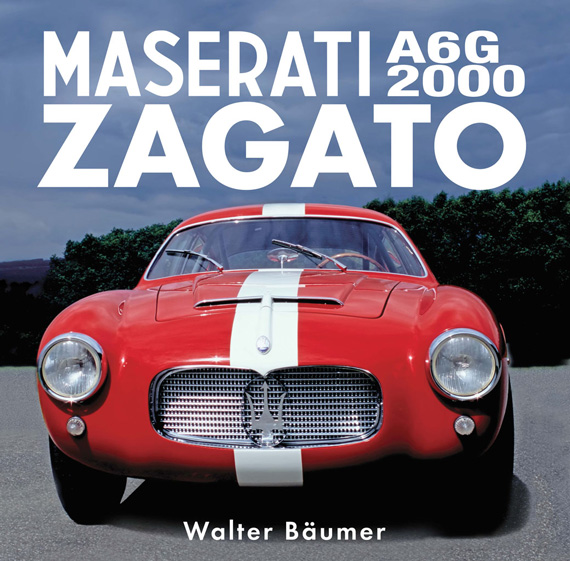
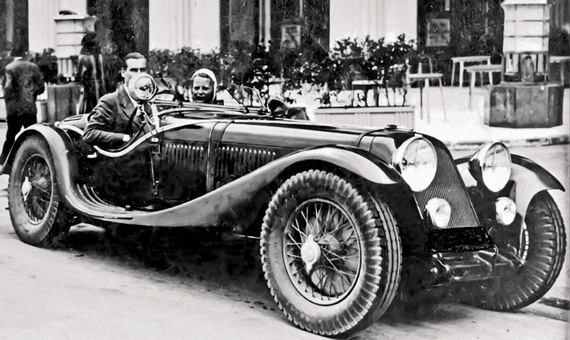


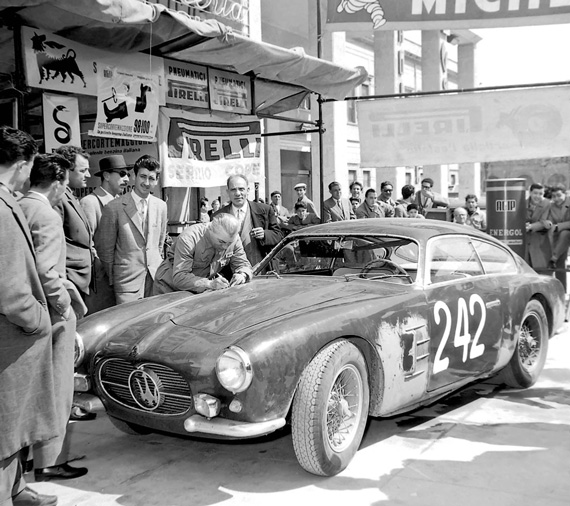
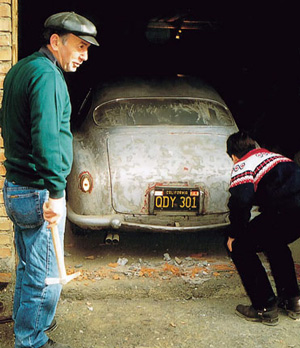
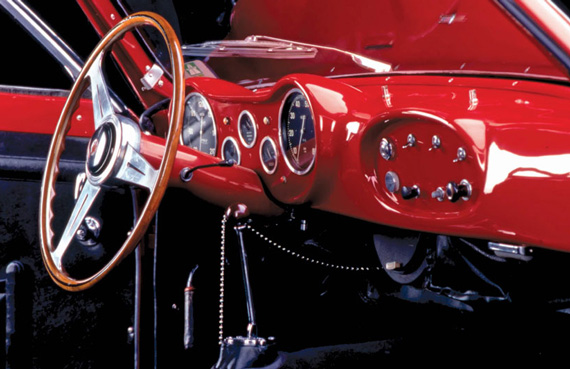
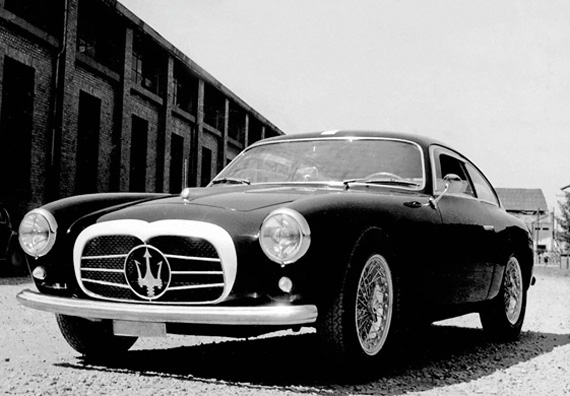

This is the one car that never ages, always fascinates me as much, embodies the 1950s is on my number 5 list. Simply stunning, even after all these years.
Walter Baumer’s previous masterpiece set the standard for Maserati historical literature and this book continues the tradition. Congratulations Walter, well done indeed.
REGARDING THE A6G2000, there is a very good 1/18 scale die cast model of this car made by Rico, no longer imported into the USA. E-bay might be a good source as a substitute if you can’t find a real car. It’s a 1954 version, windshield is wraparound similar to GM’s of ’54-5 with vertical A pillars, no bumpers, and exposed side exhausts on the driver’s side. The grille is a full oval without the widow’s peak at the top center and the hood is smooth without a windsplit. Road wheels are nicely molded in plated plastic but can be upgraded with real wire wheels from the aftermarket with a bit of searching. Dave Cummins
Your readers who have interest in scale models might like to know that Car Model in Italy offers a very nice new 1:43 model of the Maserati Zagato that looks to be S/N 2186 by Neo Scale Models for about $100.00 with shipping. These are very good models, and Car Model has a very good and extensive website. They are a pleasure to do business with, very reliable. One caution: as we all learn, this can get addictive.
Jim
This is a beautiful car. It seems like Zagato used similar designs on the early Fiat the Maserati as well as the Alfa Romeo 1900C SS Zagato. Don`t get me wrong these are great cars. I helping restore a AR 1900C SS Z at this time.
When I wish upon a star , I wish my wish would be this car ….. Maser Zagato all the way with double bubble they never age … Under the circumstances it will never be.. I’m way too short on the Dough Ray Me.
“while the Bristol Zagatos were well off the mark”
I say steady on old bean, Mopar power, Bristol chassis and Zagato body “off the mark” I must be blind.
Being an Architect, I don’t think its fair to share the magnificient Alfa 1900 SS Zagato among the misfits of the Zagato legacy. The nose is a bit unusual due to its aerodynamic form but its by no means ugly. The contours of all the 1900SS cars with a zagato body are as elegantly beautiful as those of the A6G cars. The Zagato family consider these Alfa 1900’s as highlights among all cars they’ve made.